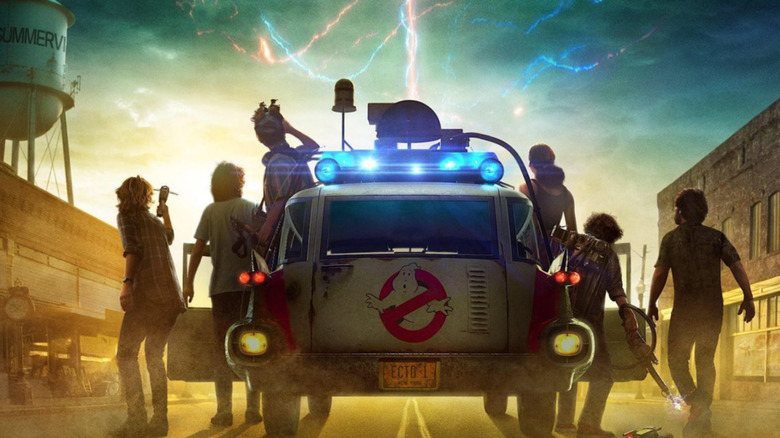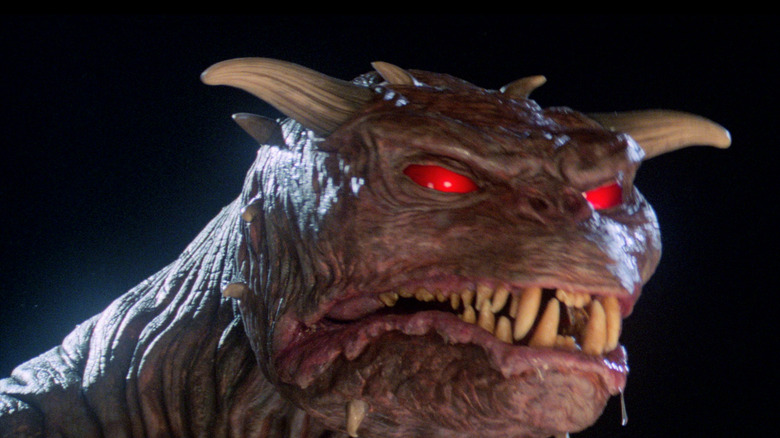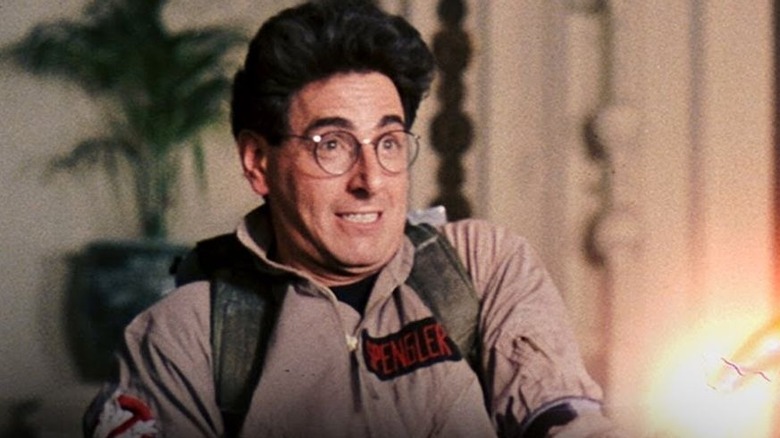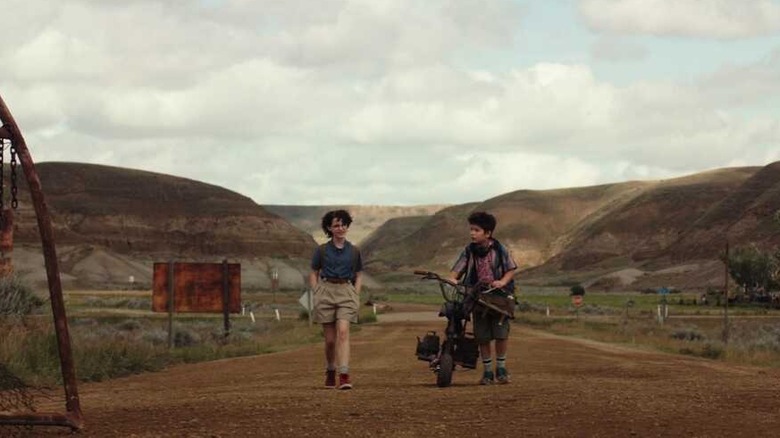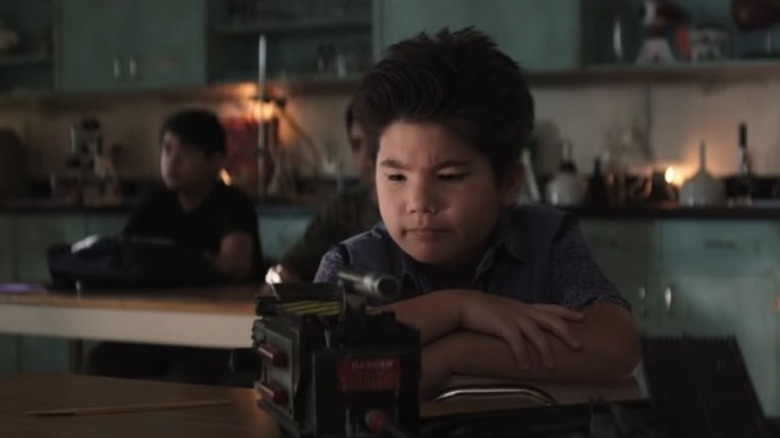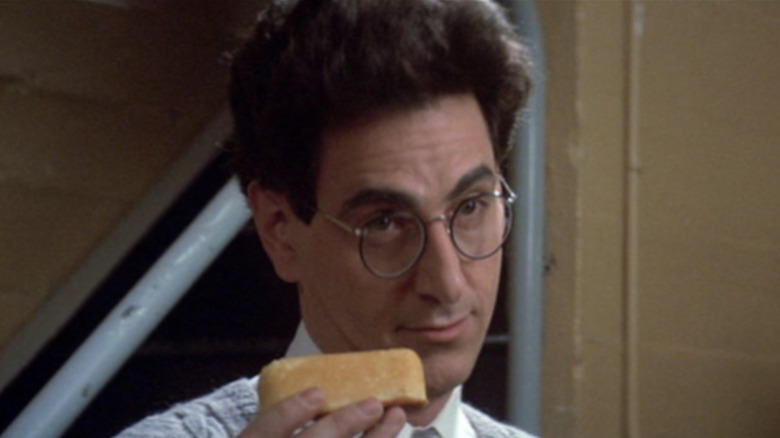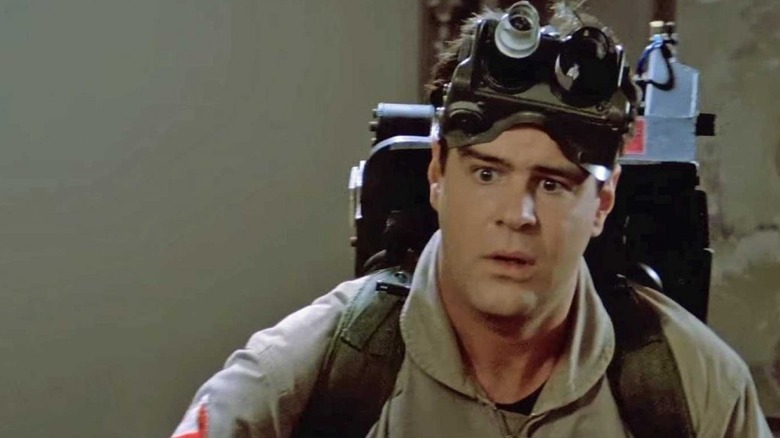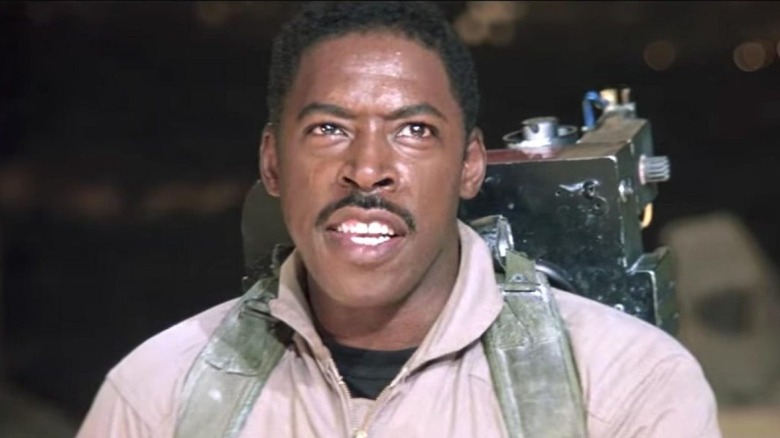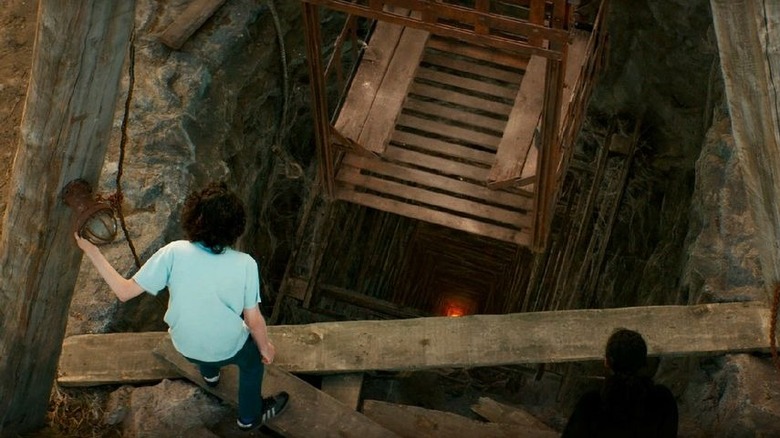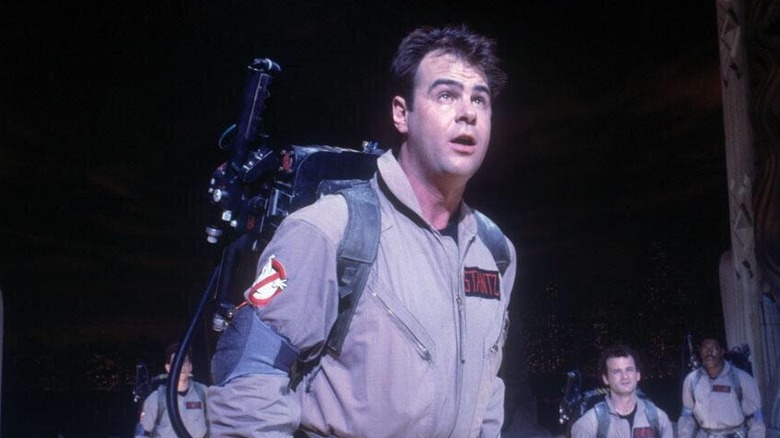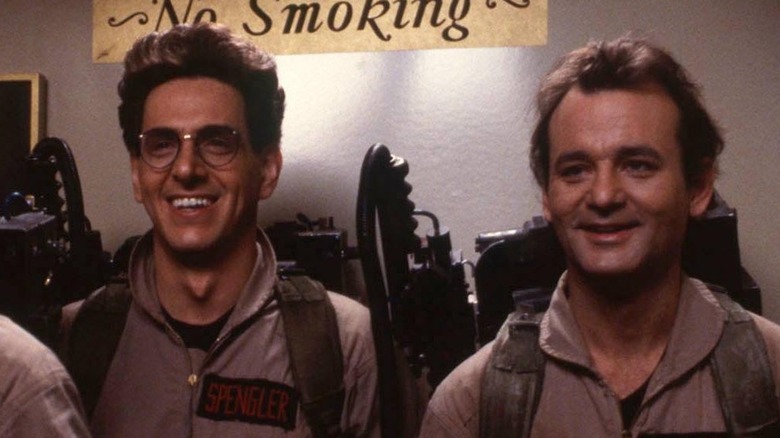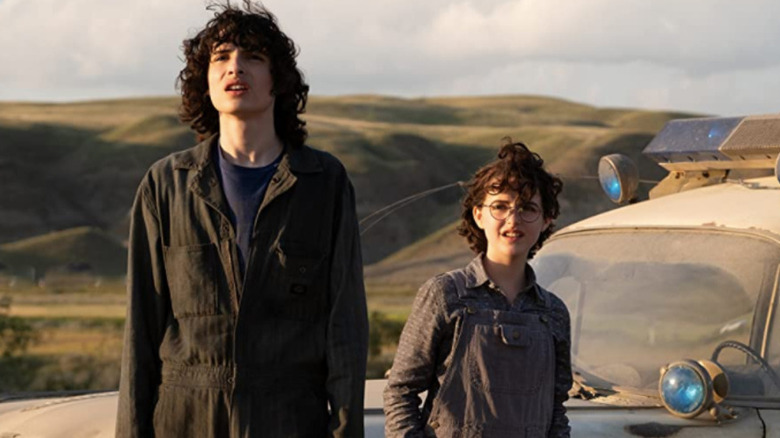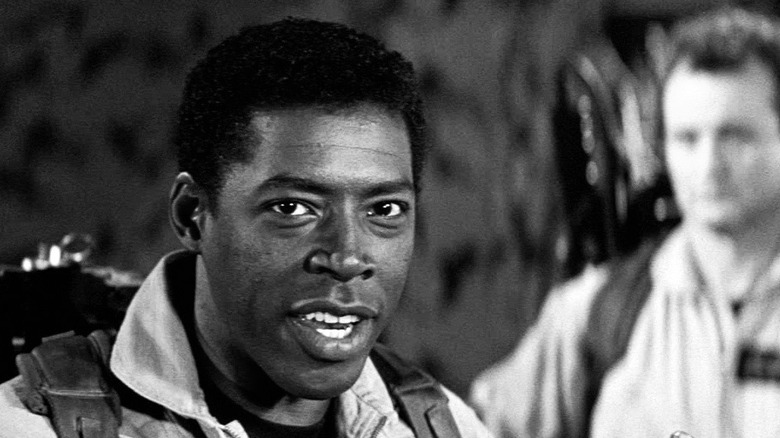Ghostbusters: Afterlife Easter Eggs You May Have Missed
In a recent feature for The A.V. Club, writer Matt Schimkowitz highlights the distressing trend of fan service he feels present in "Ghostbusters: Afterlife." Most prominently: The movie's surplus of fan surrogates. "Traditional audience surrogates speak to the viewer's logic and put their point of view on screen," Schimkowitz explains. "A fan surrogate focuses on a specific viewer who knows everything about the cinematic universe unfolding before them ... allowing a movie like Reitman's 'Ghostbusters: Afterlife' to speak the language of the fan community, verbalizing all its desires, interests, and moods." To Schimkowitz, "Ghostbusters: Afterlife" is a self-serving mirror for the "Ghostbusters" faithful — the ones who lambast "Answer The Call" too harshly, who luxuriate in the Stay Puft Marshmallow Men returning (even if their return makes little sense).
Given that, one might think that the Easter eggs in "Ghostbusters: Afterlife" would border on the obnoxious. Instead, the best of them reveal a movie that's in conversation with Ivan Reitman's "Ghostbusters," not reverently shouting over it. These Easter eggs err on the side of fan appreciation even when "Ghostbusters: Afterlife" fails to. Here are 12 of them you may have missed.
The forthcoming slides contain massive spoilers for "Ghostbusters: Afterlife" – proceed at your own risk.
Zuul's Assassination of Egon
I've written about why the opening prologue of "Ghostbusters: Afterlife" rips, and I wholeheartedly stand by my assessment. The sequence is terrifically tense, and confirms Jason Reitman is trying to up his game as an action craftsman from the jump. That said, it's also a nifty bit of telegraphing. According to "the 15-minute movie method," you can see hints of where an entire film is headed within the start of its first act, which certainly applies here: Even though the presence of "Ghostbusters" characters like The Key Master, Zuul, and Gozer are twisty reveals in "Ghostbusters: Afterlife," Reitman tips his hand that they're returning here.
How? Simple — the way that Egon Spengler ("The Dirt Farmer") perishes. As "Ghostbusters: Afterlife" opens, Egon is speeding home to what is later dubbed the Murder House, tailed by a spectral presence. Upon arriving, he races to the farm's deck and unholsters a PKE Meter. This appears to be how he'll best his ghostly foe, except something goes horribly wrong. Knowing he's not long for this Earth, Egon retreats inside to leave a few temporal clues for whoever might see them. He is then surrounded by smoke which billows in under the door and murdered in the armchair where he sits.
Does any of this sound familiar? It should. Zuul entered Dana Barrett's apartment in the exact same way during "Ghostbusters," similarly possessing her in an armchair by reaching its claws through the fabric. The goal and result with Egon are assassination, but the method and approach are kindred. This is no strange ghost — only Zuul.
The Stacked Books in Egon's Murder House
For much of "Ghostbusters: Afterlife," the spirit of Egon Spengler attempts to aid his family: He leads them to old ghost-busting equipment; he directs his daughter to photos of her as a child to redeem his absentee parenting (no, really), and even reveals clues about Shandor's mine. But what becomes abundantly clear by the conclusion of "Ghostbusters: Afterlife" is that Egon had no way of knowing who'd show up to his recently departed farm first. Would it be his love, Janine? His estranged family? Or even his old friends, the Ghostbusters? Egon simply has no clue, so he does what any good scientist would — accounts for multiple possibilities with many, many variables, one of which is the most moving Easter egg that "Ghostbusters: Afterlife" deploys.
When the Spengler kids are touring the late Egon's home, they find a stack of books that's seven or eight feet high. This recalls the first act of 1984's "Ghostbusters," when Venkman, Stanz, and Spengler — scouring Bryant Park Library for a poltergeist — come upon a tower of tomes. Spengler claims it's a sign the ghost they're searching for is near, with Venkman retorting "You're right, no human would stack books that high." Whether Venkman was right or not, his comment proves heartbreakingly prescient. The tower of manuscripts is a sign from Egon's ghost that something supernatural's afoot, and a signpost to fans that Jason Reitman played close attention to the original.
Early Sightings of Shandor
Ivo Shandor is the Cult of Gozer's founder, an imposing figure who served as the primary antagonist of "Ghostbusters: The Video Game" and has been played by both Brian Doyle-Murray and J.K. Simmons. But in "Ghostbusters: Afterlife," Ivo Shandor is a misdirection. The film builds him up to be a formidable big bad for its first two reels before promptly ripping him in half. That build-up, however, is even more layered than it appears at first glance, and provides some of the best Easter eggs in "Ghostbusters: Afterlife."
Let's start with the more obvious one: The primary mine in Summerville, Oklahoma is literally owned by the Shandor Mining Company, and signs for said company (seen throughout the first act of "Ghostbusters: Afterlife") all but underline in neon that Ivo will need to be reckoned with. But in a blink-and-you'll-miss-it detail, when Podcast takes Phoebe to said mountain he points out some art-deco hieroglyphics which score its surface. Those hieroglyphics, upon closer examination, are a perfect recreation of the statue layout that topped Dana Barrett's building in the original film. "Ghostbusters: Afterlife," it seems, tips its hand right from the very beginning. It's not just Shandor we have to worry about — it's Gozer.
Mr. Grooberson's Horror Movie Collection
The best comedies stack jokes in service of their story — even a film like "Blazing Saddles," ostensibly a series of surreal and side-splitting sketch pieces, finds funny ways to push the plot forward. "Ghostbusters: Afterlife" is no different. One of its better recurring gags contains a great Easter egg that tees up major revelations for Phoebe and Podcast.
We haven't discussed Paul Rudd's Gary Grooberson much yet, mostly because he's an elevated bench player brought to life by Rudd's A-list charms and mischievous nature. Case in point: Grooberson shows his students (Phoebe and Podcast) old horror movies like "Cujo" instead of actually teaching them. One of these movies (and here's our Easter egg) is 1988's "Child's Play." The idea of an adult showing grade-schoolers a movie where toys commit murder is amusing enough, but the kids' unfamiliarity with both it and "Cujo" (released in 1983) perfectly backs up the plot twist which follows them: That none of them have heard of the 1984 New York hauntings which are the primary thrust of "Ghostbusters."
And so, when Grooberson loads up YouTube clips of the Stay Puft terrorizing Manhattan (which in and of itself is an Easter egg, as much of the footage is comprised of shots deleted from the original "Ghostbusters"), we're more willing to believe it's the first time Phoebe and Podcast are seeing it. It's a top-tier comedy move, and one which both honors and builds off of the "Ghostbusters" legacy ... as opposed to just being overly reverent of it.
The Twinkie
One of the more bizarre wrinkles of "Ghostbusters" fandom is watching cast-off jokes from Ivan Reitman's film become Wikipedia-worthy entries. Case in point: Egon's Twinkie. Used to explain the uptick in supernatural forces during the second act of "Ghostbusters," the Hostess dessert's appearance has inspired band names and a lovely callback in "Ghostbusters: Afterlife."
When the kids go out to hunt Muncher (a ghost who chews on and through anything), they do so in the Ecto-1, Egon and the Ghostbusters' old vehicle. Being minors and having already caused plenty of chaos during their attempted capture of the ghost, they are eventually pulled over by a Summerville police officer who demands to see their license and registration. Trevor (Finn Wolfhard) has enough sense to check the glove compartment for the latter, but instead of necessary papers, he finds only Egon's last Twinkie. It's a surprising moment, but one which also seems in keeping with Egon's character. Here was a man so obsessed with the paranormal that he was more like to have his favorite comfort food on him than important documents (given his brushes with the EPA, this tracks). Sometimes it's the cast-off jokes which offer the richest resonance.
Ray's Occult Books
When the trailers for "Ghostbusters: Afterlife" first dropped, fans spotted the original "Ghostbusters" logo on the new Ecto 1 instead of the "Ghostbusters II" version, leading some to wonder if the original's 1989 sequel remained canon. Over the last two weeks, director Jason Reitman confirmed as much. Had fans waited until they'd actually seen "Ghostbusters: Afterlife," however, they would have seen ample proof that "Ghostbusters II" is canon — namely, Ray's Occult Books.
In "Ghostbusters II," Ray Stanz opens an occult book store following the collapse of his ghost-fighting squad. We learn, touchingly, that Venkman and Spengler were frequent customers of it. And when "Ghostbusters: Afterlife" first catches up with Ray Stanz (when Phoebe is in jail and needs to call someone who's ready to believe her stories of spirit-hunting), we find him — where else? — in Ray's Occult Books.
The loveliest component of this touch is far more than nostalgia-baiting or continuity-confirmation; it's the implication that Ray has remained steadfast in his belief, even as relationships with his friends dissolved. The events of '84 and '89 shaped Stanz irrevocably (much as they did Dan Aykroyd) and Ray's continued stewardship of his tiny store is both a wonderful Easter egg and a bit of character building.
Revelations 6:12
Speaking of character-building, when we see Ray Stanz on the phone with Phoebe, he is sporting fresh ink. A tattoo of "Revelations 6:12" can be seen on Stanz's arm, which is found in King James' Bible and reads as follows: "And I beheld when he had opened the sixth seal, and, lo, there was a great earthquake; and the sun became black as sackcloth of hair, and the moon became as blood." Fans of the first "Ghostbusters" will recall Stanz misquotes this exact passage as "Revelations 7: 12" to Winston as both are trying to process the increased amount of paranormal hauntings happening around them.
So it isn't for nothing that Stanz now has Revelations' memorable entry permanently written on his skin — it's forever signed upon his soul, emblematic of a moment that changed the trajectory of his entire life. He's become a true believer, be it in the Bible or the supernatural or both.
But the verse is also crucial foreshadowing in "Ghostbusters: Afterlife." When Spengler's family first pulls up to Egon's farm, there's a sign displaying "Revelations 6:12" prominently displayed at its entrance. The message is clear to those who could see it: Egon believes again that the end is coming, and — given his history with saving the world — it's almost certainly an entity who turns the sky red. In the case of Ray and Egon, they're ready to believe it.
A History of Hauntings
Historical context is a quick way to grant instant importance to the seemingly casual. In the case of "Ghostbusters: Afterlife," a single sequence from its midpoint not only ups the stakes its young protagonists are facing, but also adds gravity to "Ghostbusters" and "Ghostbusters II."
When Phoebe, Podcast, Trevor, and Lucky (Celeste O'Connor) descend into Shandor's mine, they find a series of dates inscribed upon the walls, each of which corresponds to various real-life disasters. One of these is 1908, which would refer to the Tunguska Blast, in which a meteor exploded over the plains of Siberia causing 830 square miles, 80 million trees, and an unknown number of people to be wiped off the Earth. If this sounds familiar to you, it might be because Ray inaccurately refers to the blast occurring in 1909. This not only builds on the gag of Ray being off on everything by one number — it's also a strong indication as to why the original Ghostbusters might have missed a malevolence was set to terrorize the world in 2021.
The other years listed there? 1984 and 1989 are among them, which, of course, are the years in which Gozer and Vigo The Carpathian haunted New York. If there was any doubt as to just how connected "Ghostbusters: Afterlife" is to Reitman's other "Ghostbusters" films, this Easter egg settles the matter firmly.
Ray Is A God
Old habits die hard. John McClane can't help but fall into trouble. James Bond orders martinis shaken, not stirred, no matter what mission or threat he's facing. So while it's reasonable to assume that, 40 years removed from staring down a paranormal force bent on wiping humanity from existence, Ray Stanz would've broken a habit that almost cost him his life, we all know that isn't how it works.
"Ghostbusters: Afterlife" reunites Ray not only with his team of spook-fighters but also the villain they encountered back in '84. Asked once again by Gozer if he is a God, Ray remembers to say yes this time ... but only after hesitating for a few beats. It's one of the nicer callbacks "Ghostbusters: Afterlife" incorporates into the proceedings, all the more so because Ray delaying his answer in the face of evil is still objectively funny whether you have or haven't seen "Ghostbusters." That makes it an Easter egg for much of the film's younger audience, and one that reinforces that the Ghostbusters' arrival is as much out of habit as growth.
"I Thought You Might Show Up"
At the end of "Ghostbusters: Afterlife," a chryon appears on the screen. It reads, simply, "For Harold." Whatever you make of Jason Reitman's film, it's hard not to be moved by this simple bit of text, as it confirms what was clear from the preceding two hours — it is a heartfelt labor of love.
An example: Ramis' Egon (played by Bob Gunton here) doesn't speak in "Ghostbusters: Afterlife," with Bill Murray's Venkman speaking for him during their confrontation with Gozer. Their subsequent catch-up — which revolves a mentioned feud between Egon and Venkman — is fleeting, funny, and more than a little melancholy. It feels strikingly intimate, possibly because it borrows from real life.
Off the silver screen, Ramis and Murray didn't speak for more than two decades. According to Violet Ramis Stiel's memoir/biography Ghostbuster's Daughter: Life With My Dad, Harold Ramis, Ramis and Murray had such intense creative disagreements on the set of "Groundhog Day" that "one day Ramis grabbed Murray by the shirt collar and threw him against a wall. After that, Murray didn't speak to Ramis for over 20 years." This continued until just before Ramis passed, when "Murray showed up unannounced at his old friend's house at 7 a.m. with a box of doughnuts and a police escort. Ramis had pretty much lost his ability to speak by that point, so Murray did most of the talking."
It's not clear this is directly referenced by "Ghostbusters: Afterlife," but it's impossible to imagine a world where the matter wasn't felt on-set in some way, if only in its talent's minds. It also helps distinguish "Afterlife" from becoming the exercise in fan service many worried it would be.
Deleted Scenes Become Canon
Like most modern-day blockbusters, "Ghostbusters: Afterlife" contains not one but two post-credits scenes — and if you're exhausted just reading that sentence, I empathize. We're in an era where entertainment comes packaged with the promise of more entertainment, where films can exist to shore up future projects (and, in the process, hopefully create deafening waves of buzz). It can be a bit much for viewers who don't want movies to feel like homework. That said, the post-credits sequences of "Ghostbusters: Afterlife" feel more like extra credit than additional assignments.
Case in point: the second of the two scenes (which we'll detail further in just a moment), opens with old footage of Egon receiving a medal at the World's Fair. And though it would be fair to assume it's a bit of posthumous CGI given Ramis' untimely passing, the scene is actually a deleted sequence from the original "Ghostbusters." The decision helps make the moment as much a love letter to the first film and the fans, one which tees up some major revelations...
The Ghost Containment Unit's Been On The Whole Time
If I'm being transparent, I always thought Winston Zeddemore was underrated. He had the best name of any Ghostbuster, and as portrayed by the indelible Ernie Hudson, there were depths to him that felt lifted from a different, emotionally richer movie. You could feel it while watching the original as a kid, and if Jason Reitman's post-credits scene for "Ghostbusters: Afterlife" is any indication, he did too. Yes, the scene's big bombshell is that the ghost containment unit which was shut down by EPA pencil-pusher Walter Peck ominously flashes back on, a single red light glowing. But the scene also leaves the audience with a richer sense of who Winston Zeddmore is, and that is — in its own way — a massive Easter egg.
Hudson has made no secret of the fact that the "Ghostbusters" script he signed on for had a richer backstory for Winston than the one which appeared in the film's final cut. The character didn't even appear on the film's primary movie posters! Winston, it seemed, was more of an afterthought than the movie's other three, comic white leads. Here, in "Ghostbusters: Afterlife," Winston is not only given more due but the proverbial keys to the kingdom. He's purchased the old firehouse headquarters. He's positioned at the forefront of wherever the franchise heads next. Winston's status has risen, and it's about dang time.
